Wonders of The Universe s01e04
Messengers
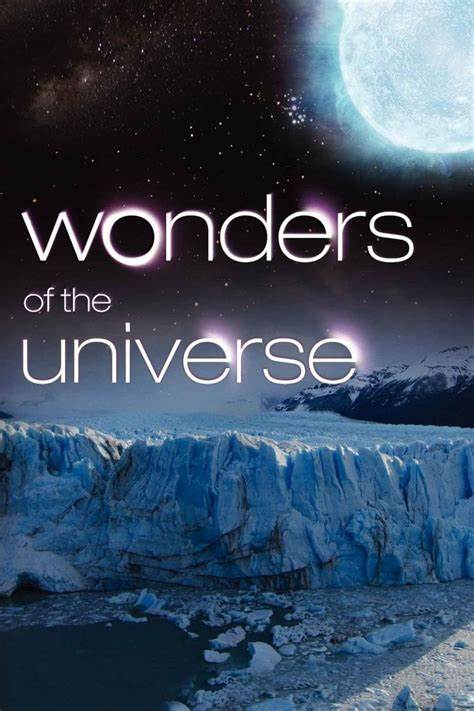
Why are we here? Where do we come from? These are the most enduring of questions and it's an essential part of human nature to want to find the answers. And we can trace our ancestry back hundreds of thousands of years to the dawn of humankind, but in reality, our story extends far further back in time. Our story starts with the beginning of the universe. It began 13.7 billion years ago. And today, it's filled with over a hundred billion galaxies, each containing hundreds of billions of stars. In this series, I want to tell that story, because ultimately, we're part of the universe, so its story is our story. It's a story that we wouldn't be able to tell, were it not for the one thing that connects us vividly to our vast cosmos.
Light.
Light reveals the wonders of the universe in all their glory - stars that shine with the light of a thousand suns, and vast swirling galaxies. But light is also a messenger from a long-forgotten era, and contained in the light from these faraway places is the story of our universe's origin and evolution. Through light we can stare back across the entire history of the universe and discover how it all began, and ultimately see how light breathed life into us.
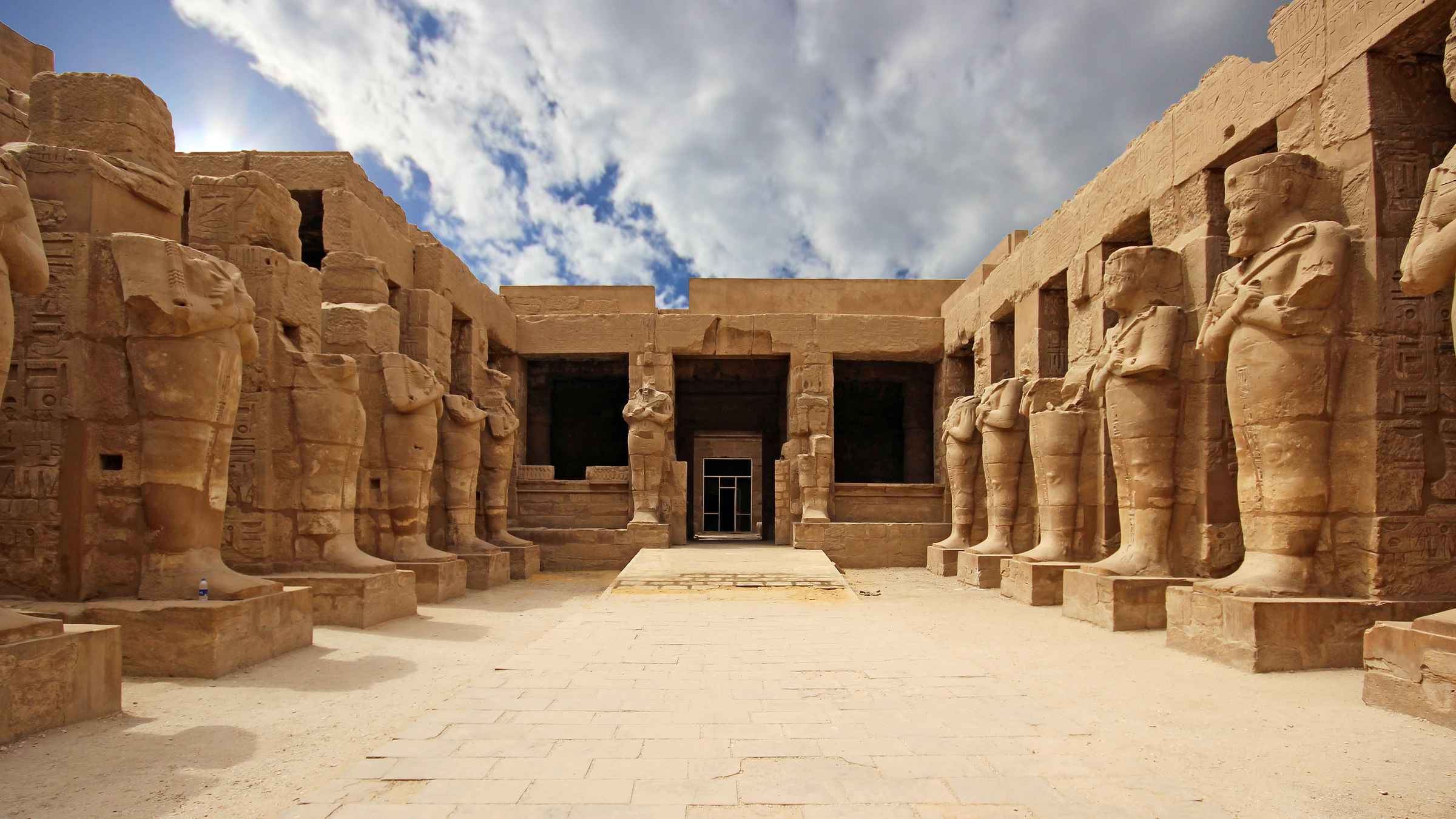
Figure 1. Karnak Temple
This is Karnak Temple in Egypt. Built by the ancient pharaohs, this vast complex was erected to honour Amun Ra, god of all gods, god of the sun. This worship reaches its peak during one fleeting moment in the solar calendar, an event so brief it lasts for little more than a minute. This temple is built to align with an astronomical event that happens just once a year - the sunrise at the winter solstice( ˈsɒlstɪs 至日).
"Solstice" is Latin for "sun stands still" because as the Earth orbits around the sun and the year passes, the point at which the sun rises above the eastern horizon moves, so here in Egypt in summer, the sun rises over in that direction, and then as summer turns to autumn, turns to winter, the sunrise point drifts along, until today on December 21st, at 6:30am in mid-winter, the sun rises exactly between the pillars of this temple.
Just once a year, for over 3,000 years, the sun has risen between the two pillars, and casts its light into the temple. There it is, the light from our star cascading down this magnificent structure. I mean, you can literally feel the history of this place, so it's easy to forget that this is 3,500 years old, so in 1500 BC, the most powerful man on the planet, the Pharaoh of Egypt, would have stood here on December 21st every year, just to greet and experience the light from Amun Ra.
This moment that the Egyptians worshipped instinctively we now understand in exquisite detail. As the Earth journeys through the Solar System, it's bathed in the light of the star that sits at its centre. This light has travelled some 150 million kilometres from the surface of the sun. And at the winter solstice, that light pours into the temple at Karnak. Well, this building is honestly the most magnificent structure I've ever seen. Now, it's not built on the scale of men. It's built on the scale of gods, of one god, Amun Ra, the god of the sun.
As the sun sinks below the horizon and night falls, the whole universe of suns fades into view. We no longer build temples to our sun, we build machines that allow us to peer deeper into space than ever before, to far distant suns out there in the galaxy, and beyond. On a night like this, there are about 2,500 stars visible to the naked eye, but when we started building telescopes instead of temples, we discovered that there are billions more. Every star we see in the night sky is a sun that sits within our own galaxy, the Milky Way.
As we step away, our sun gradually fades to become just one dot in a sea of stars. We now know that we're about halfway out from the centre of this beautiful cosmic structure, but even though these worlds are many millions of kilometres away, we know them intimately by their light. These waves of light are messengers from across the cosmos, and through them, we've discovered the wonders of our galaxy.
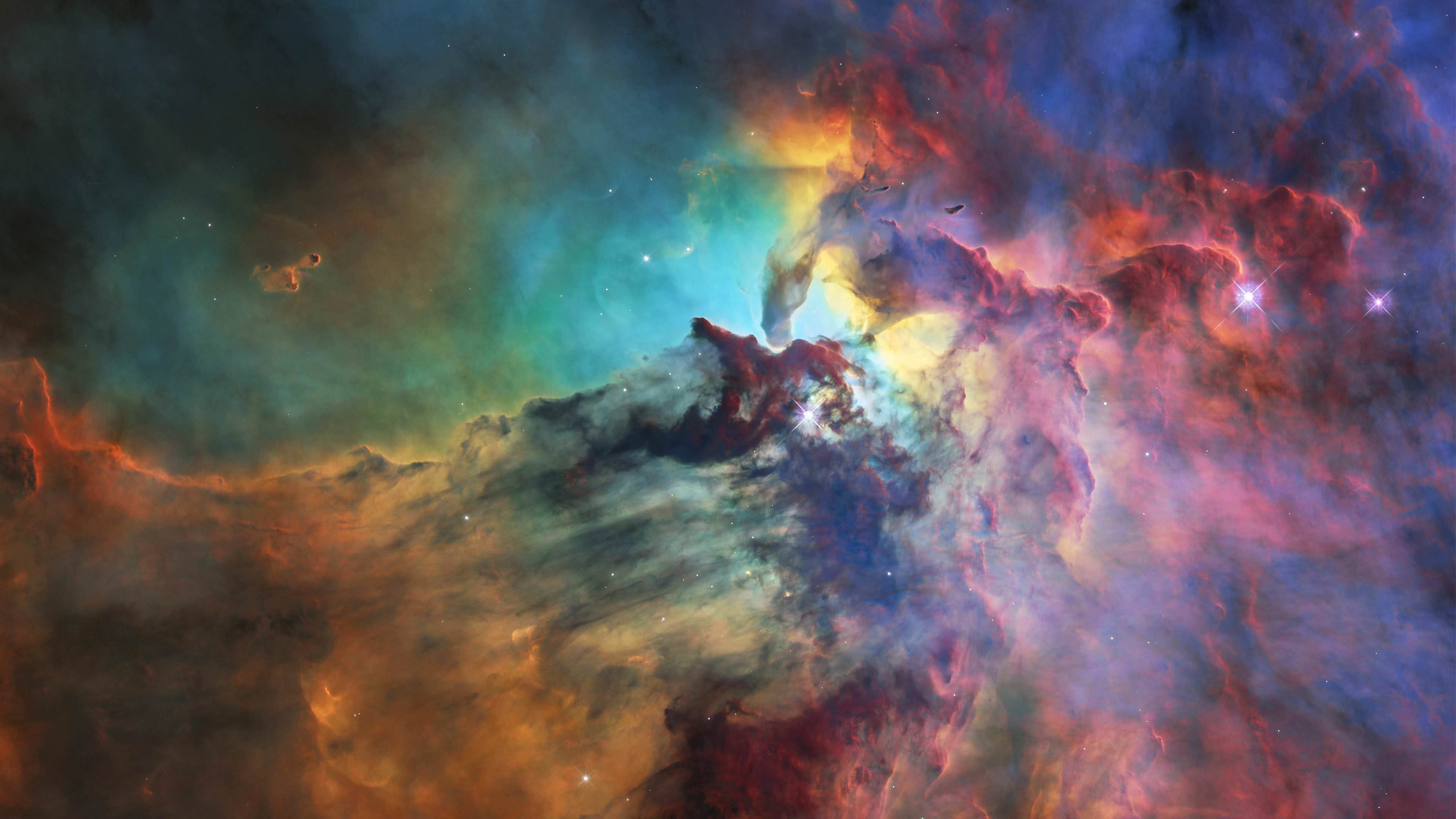
Figure 2. Charming Lagoon Nebula
This is the Lagoon Nebula(ləˈɡuːn ˈnebjələ 礁胡星云 ). From a distance, this cloud of dust and gas appears beautiful and serene. But this is a furnace where new stars are forged. The Lagoon Nebula sits about 5,000 light years from Earth, but it can still be seen with the naked eye, because it's 100 light years across, and brightly lit by the hot, new, young star that sits at its centre, a giant called Herschel(ˈhɜːʃəl 天王星 )36.
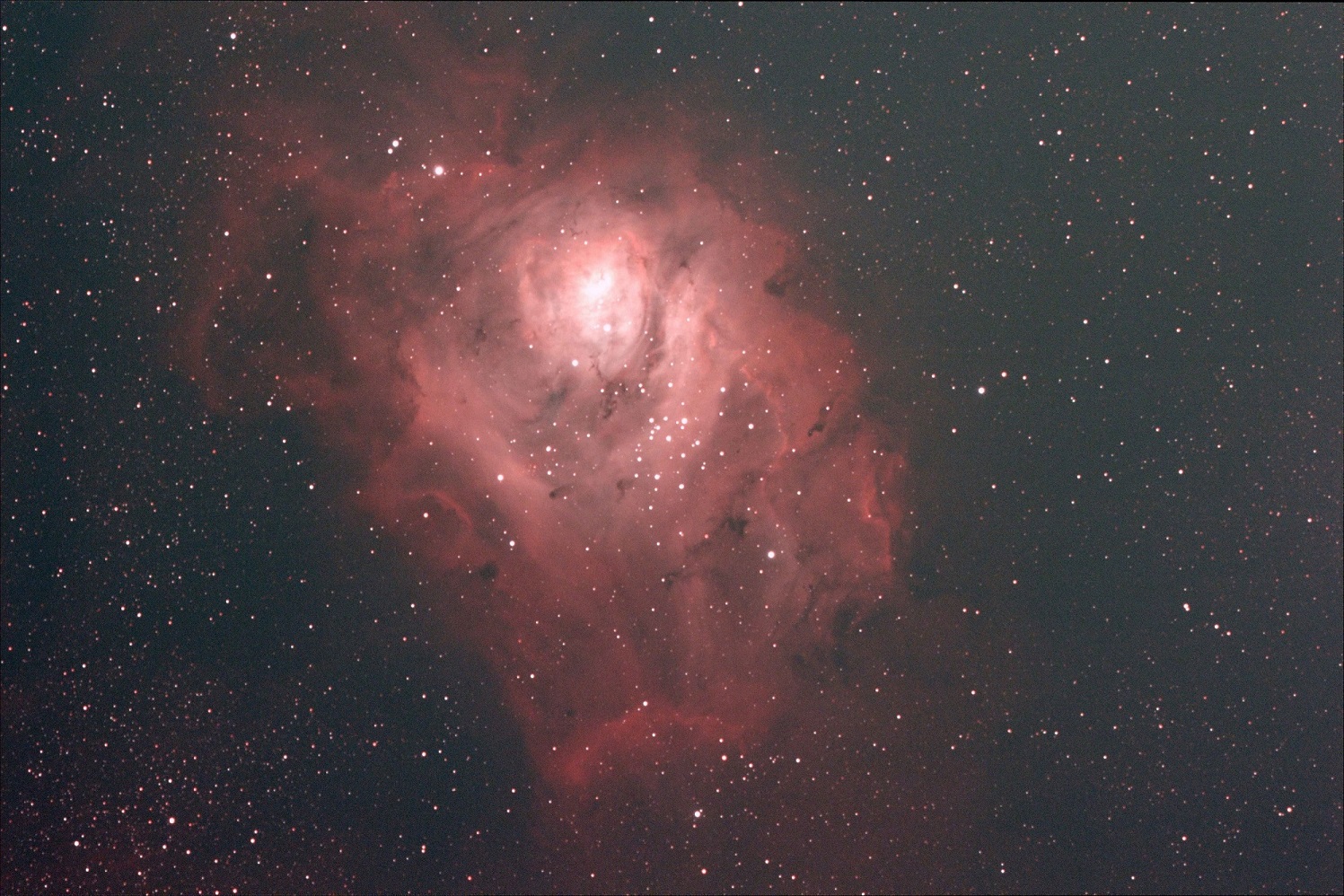
Figure 3. Herschel 36, a giant star
This newly born star is over 20 times more massive than our sun, and burns much hotter, which makes the light that pours from its surface blue. And there are even bigger stars in our galaxy. 7,500 light years from Earth is a star that dwarfs even Herschel 36. Its name is Eta Carinae (ˈiːtə kəˈriːni 船底座海山二星). This monster star is over 100 times more massive than our sun, and burns about four million times brighter, making it one of the most luminous stars in the Milky Way. All we know about these incredible worlds has been brought to us on wave after wave of light.
Our galaxy is a symphony in light. The Milky Way is home to 200 billion stars, but our galaxy is just the beginning. For each of these stars, there are a billion more in the universe beyond. Across the unimaginable reaches of space, light has allowed us to journey to the most distant galaxies, to see the births and deaths of stars. No matter how far we follow the light, no matter how many billions of miles we cross, the nature of light itself allows us to go on a much richer journey, because to look up, and to look out, is to look back in time.
Those ancient beams of light are messengers from the distant past, and they carry with them a story, the story of the origin of the universe. In order to read this story, to see how light can transport us to the past, we must first understand one of its fundamental properties - its speed. Everything in our universe has a speed limit, even intangible phenomena like waves of sound and light. These speed limits are very real physical barriers, and they have profound consequences for our understanding of the universe.

Figure 4. Hawker Hunter, a jet that can travel at supersonic speed
Today, I'm going to try and break one of those barriers. This is a Hawker Hunter. It was built in the 1950s, when breaking the sound barrier was at the very limit of our technical abilities. A sound barrier's an incredibly evocative term, you know, it has an almost legendary status in the history of aviation, but there's nothing fundamental about it - it's something that you can overcome with some extremely clever engineering, and in the early days, quite a lot of courage. The reason we don't usually think about sound as having some kind of speed limit, a limit in speed, is because it is incredibly fast compared to the things we're used to in everyday life.
But today, we're going to try and break it. I'm going to try and break it, sat in this marvellous machine. On Earth, the speed of sound, depending on altitude is around 1,200 kilometres per hour, known as Mach I. This jet isn't designed to fly that fast in normal flight, but there is a way to make it travel faster than sound, and for that, we need to fly high. As the plane flies faster, it begins to catch up with its own sound. The sound waves simply can't get out of the way fast enough, so they begin to pile up at the front of the jet.
But to outrun our sound waves, we need to push this jet to its absolute limit. In just seconds, the jet smashes through the sound barrier. This can be heard from the ground as a sonic boom. It was a doddle, actually. Well, you know, having said that, it was inverted full throttle at 42,000 feet, but it's a different definition of "doddle". So this magnificent piece of engineering is fast enough, if you just push it a little bit, to outrun its own sound, so the sound barrier is negotiable. You can smash your way through it.
But the speed of light, the light barrier, that's a very different story. Sound has a definite speed that we can measure, but for thousands of years, the world's greatest minds thought that light was different, that it travelled instantaneously from object to eye. Then, around 350 years ago, the truth about light was revealed through a combination of one man's genius and the clockwork orbits of the heavens.
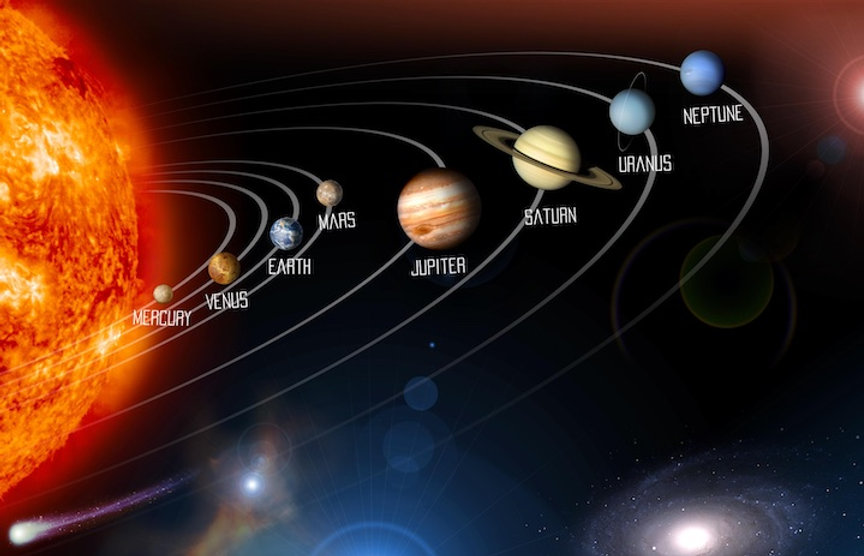
Figure 5. Not-so-accurate graph of our solar system
Ever since Galileo (ˌɡæləˈleɪəʊ 伽利略) discovered that Jupiter had moons, astronomers realised that you could use Jupiter and its moons as a very precise clock in the sky. So here's the Solar System, there's the sun, there's the Earth, here's Jupiter, and here is Jupiter's innermost moon. It was known that Io takes precisely 42.5 hours to orbit Jupiter, so if, from the Earth, you see Io emerge from behind Jupiter at say, midnight on a Tuesday, then you know that it should re-emerge again at 6.30 on Thursday afternoon.
Beautiful.
Now one of the men charged with making precise tables of exactly when Io should be seen to emerge from behind Jupiter was the Danish astronomer Ole Romer, but he noticed something surprising. See, depending on the time of year, Io emerged later than expected, or earlier than expected. Now, Romer's genius was to realise that had nothing to do at all with the orbit of Io around Jupiter. It was to do with the orbit of the Earth around the sun. See, what Romer noticed was that when the Earth was in a position in its orbit so that it was close to Jupiter, then Io emerged earlier than it was expected to.
Then, as the year passed and Earth moved around the sun and got further away from Jupiter, Roma noticed that Io then emerged later than it was expected to. Roma realised that it takes time for light to travel from Jupiter to the Earth, so when the Earth is far away from Jupiter, it takes longer for the light to travel, and therefore you see Io emerge from behind Jupiter later than you'd expect. Then, when the distance is small, it takes less time for the light to travel and you see Io emerge earlier than you might expect.
So Romer had discovered that light doesn't travel instantaneously. It moves through space with a finite speed. This remarkable insight led to a measurement of the speed of light. We now know that light travels at precisely 299,792,458 metres per second. That means in the time that it takes for me to click my fingers, light has travelled around the Earth seven times, or that it travels ten million, million kilometres in one year, and that's the yardstick that we use to measure the universe, as ten million, million kilometres is approximately one light year.
The speed of light is the speed limit of the universe built into the very fabric of space and time itself. But because light travels at a finite speed, a light year isn't just a measure of distance, it's also a measure of time. The further away an object is, the further back in time we see it. The distances that light travels on Earth are relatively short, so the time it takes light to travel to our eye is imperceptible. But when we look out to space, over astronomical distances, to the stars, planets and galaxies beyond, then light's finite speed has profound consequences.
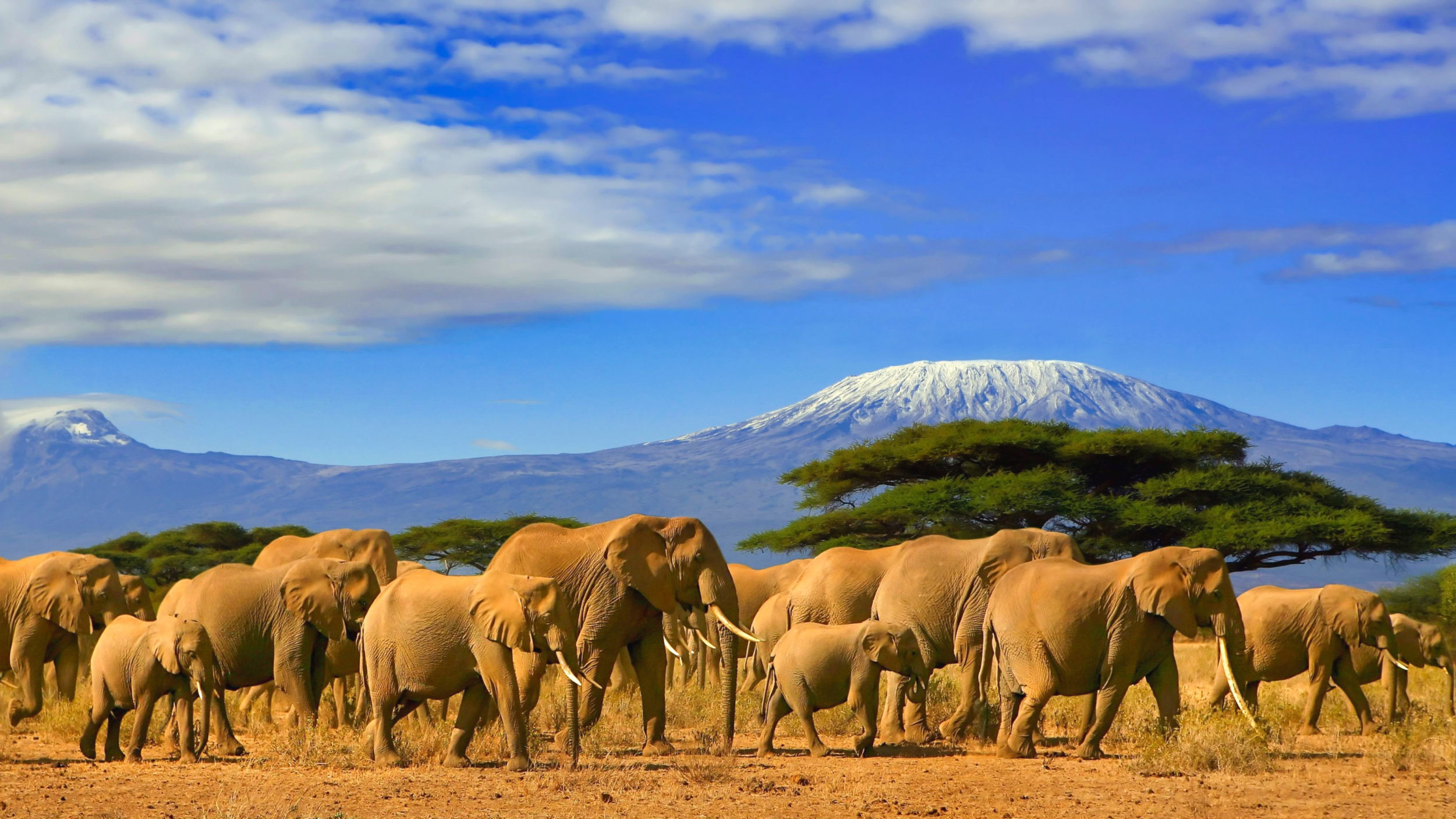
Figure 6. Scenery of Tanzania
This is Tanzania (坦桑尼亚 ˌtænzəˈniːə) in eastern Africa, the cradle of humankind. It's here that some of our earliest ancestors walked 2.5 million years ago. And our evolutionary journey from the distant past to the present day ran in parallel with the journey of the light from the stars. The sun is 150 million kilometres away. Now, that's very close by cosmic standards, but light travels at only 300,000 kilometres per second, so that means that we're seeing the sun as it was in the past, actually eight minutes in the past. But when we look beyond our sun to far more distant stars, we reach further back in time across the whole of human evolution. And the deeper into space we look, the further back in time we see.
As the sun dips below the horizon and night falls, the universe just fades into view, and at first, you see the bright planets. I can see Venus over there, and then the stars appear one by one, thousands of them shining in the sky. And then, as it gets darker and darker, the Milky Way appears, a vast swathe of billions and billions of suns as you look out towards the centre of our Milky Way galaxy. But I think, for me, the most magical thing you can see in the sky with the naked eye is just below the constellation of Cassiopeia, the W of stars in the sky.
There.
Look at that.
Actually, I've got to say that's amazing.
See, that misty patch of light is not a cloud in the sky, it's not even gas and dust in our galaxy, that is another galaxy. It's the Andromeda (仙女座 ænˈdrɒmɪdə) galaxy, which is roughly the same size as our own, an island of hundreds of billions of stars, 25 million million million kilometres in that direction. Like the Milky Way, Andromeda is a spiral galaxy, two ringed arms circling a light-filled centre. The core of Andromeda is packed with millions of old red stars. Very few new stars are born here.
In contrast, its spiral arms shine with the light from clusters of hot young blue stars. The light that pours from this stellar city connects us to a remarkable time in the story of human evolution. The light that I've just captured in my camera began its journey 2.5 million years ago. At that time, on Earth, there were no humans. Homo habilis, our distant ancestors, were roaming the plains of Africa, and as those light rays travelled through the vastness of space, our species evolved, and thousands and thousands and thousands of generations of humans lived and died, and then 2.5 million years after their journey began, these messengers from the depths of space and from way back in our past, arrived here on Earth, and I just captured them and took that picture.
Light's finite speed opens a window onto the past and shows us Andromeda as it looked when our early ancestors walked the Earth 2.5 million years ago. But by peering further than the naked eye will allow, we can journey to a time way before human history, so far back, that we can read the entire history of the universe. In the last 20 years, powerful space telescopes have carried us ever deeper into space, and we have become virtual time travellers.
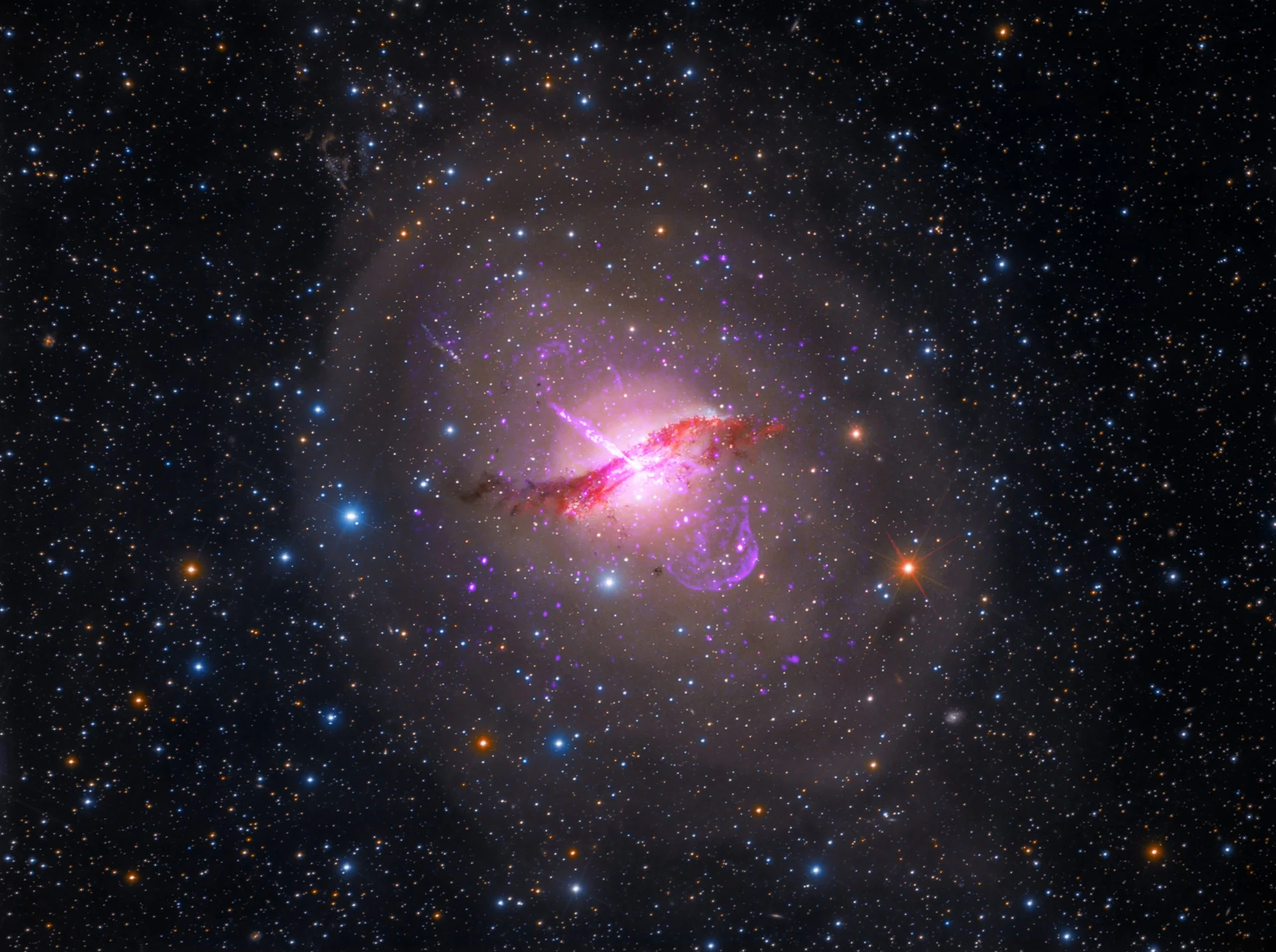
Figure 7. Centaurus A
This is Centaurus A (半人马座A ænˈdrɒmɪdə eɪ) , one of our nearest neighbouring galaxies, only ten million light years away. That means that the light began its journey from these old red, and young white and blue stars, only ten million years ago. And stepping out a little further, just 14 million light years, there's this beautiful barred spiral galaxy, and again you can see just lanes and lanes of bright young blue stars, and this blue light has taken 14 million years to journey across the universe to my eye.
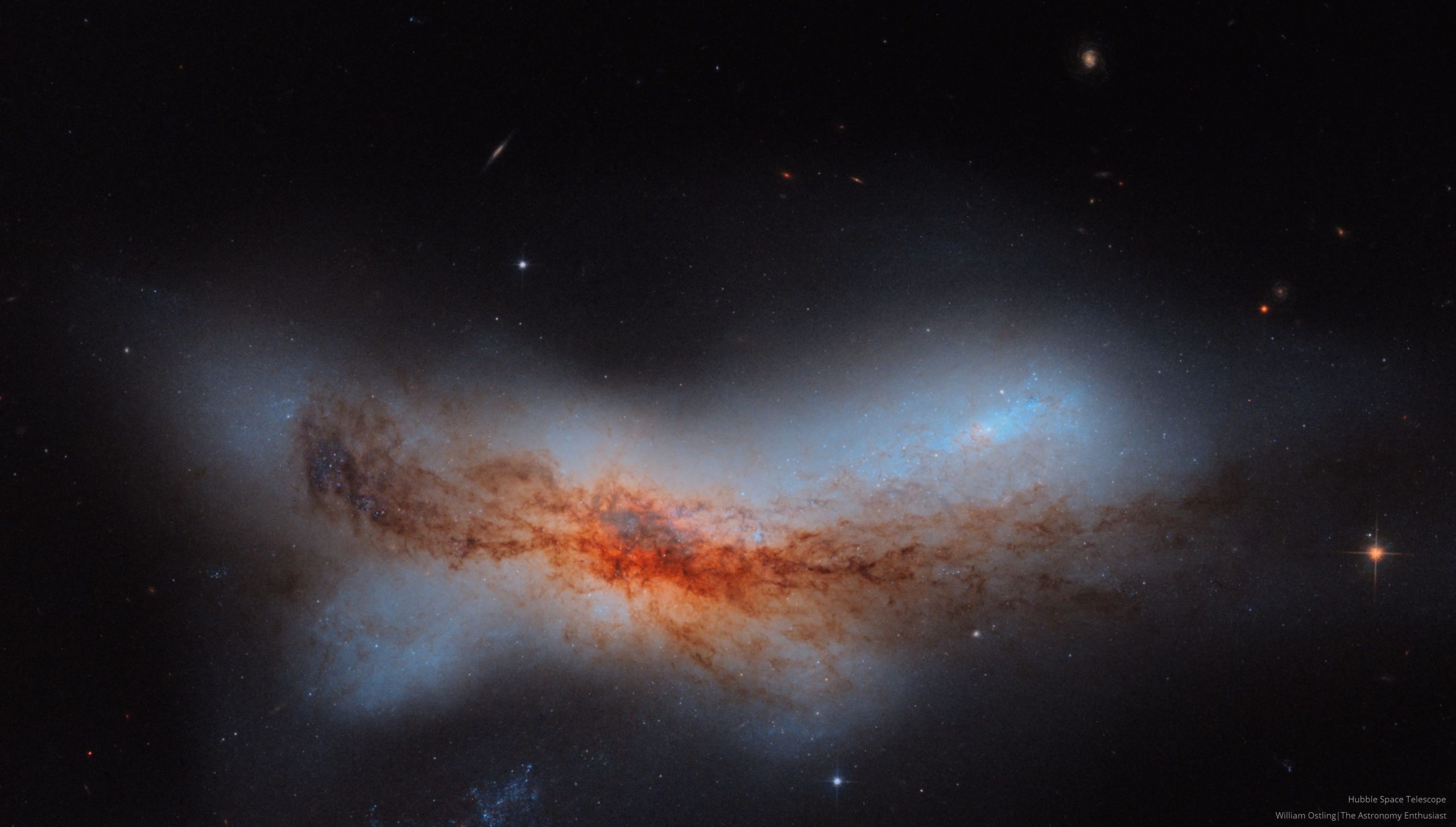
Figure 8. NGC 520, which has a different shape
This is NGC 520, and it's the product of a cosmic collision, but this galaxy is 100 million light years away. That means that the light began its journey from this galaxy to my eye when the dinosaurs roamed the Earth. I think it's a beautiful thought that by capturing this faint light and rebuilding these spectacular images, we are in a very real sense connected to these galaxies, no matter how far away they are across the universe, connected by the light that's journeyed billions of years to reach us. But these spectacular galaxies are not the end of our journey into the past.
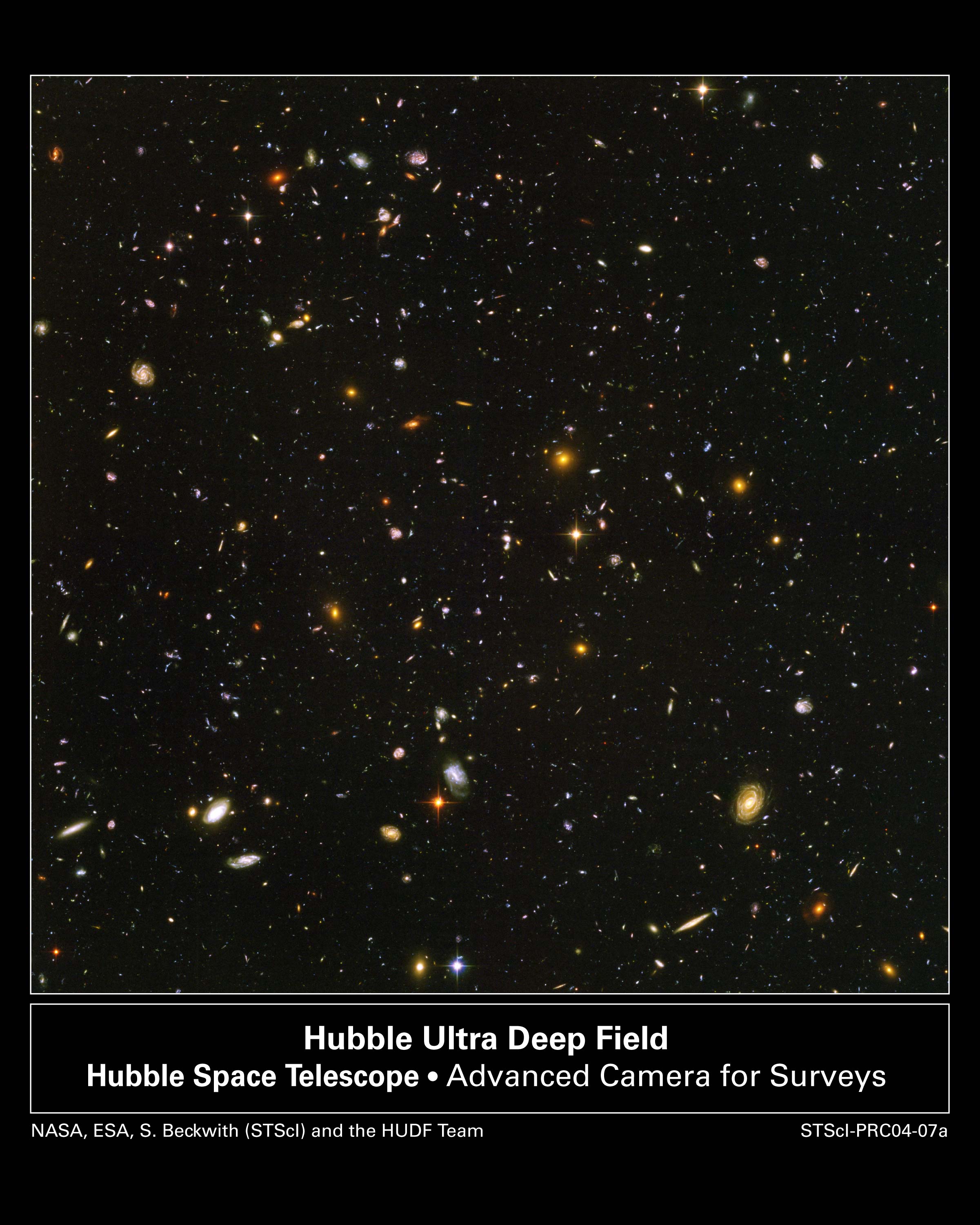
Figure 9. Hubble Ultra Deep Field uploaded by NASA
In 2004, we peered further back in time than ever before, and captured the light from the most distant galaxies in the universe. The image is called the Hubble Ultra Deep Field (哈勃超深空(哈伯深领域是外太空照片,由哈勃望远镜在113天内拍摄。它是最深远的可见光宇宙影象,显示了超过130亿年前的情况)) . It's a picture taken by the Hubble Space Telescope over a period of eleven days and it focused its camera on the tiniest piece of sky just below the constellation of Orion. Now, it's a piece of sky that you'd cover if you took your thumb, held in front of your face and then moved it 20 times further away. But the Hubble captured the faintest lights from the most distant regions of the universe, and it took this photograph.
Now, almost every point of light in that image is not a star, but a galaxy of over a hundred billion stars. The most distant galaxies in that image are over 13 billion light years away. That means that the faint light from those galaxies began its journey to Earth 13 billion years ago. That's over three times the age of the Earth. Hubble allows us to peer back almost to the beginning of time itself, and out here in deep space, it reveals a clue to how our universe began.
When the space telescope stared across the cosmos, it saw galaxies glow in all different colours. But when it peered to the very edge of the visible universe, it captured these images and saw that every galaxy glowed red. Written in the red light from these distant worlds is the story of our universe's origin and evolution. To reveal it, we must explore one of the most beautiful qualities of light. For centuries, people thought that light just illuminated our world, allowed us to see, and nothing more than that. But we've since learnt that there is a vast amount of information and detail contained within every beam of light. And that information is written in colour.
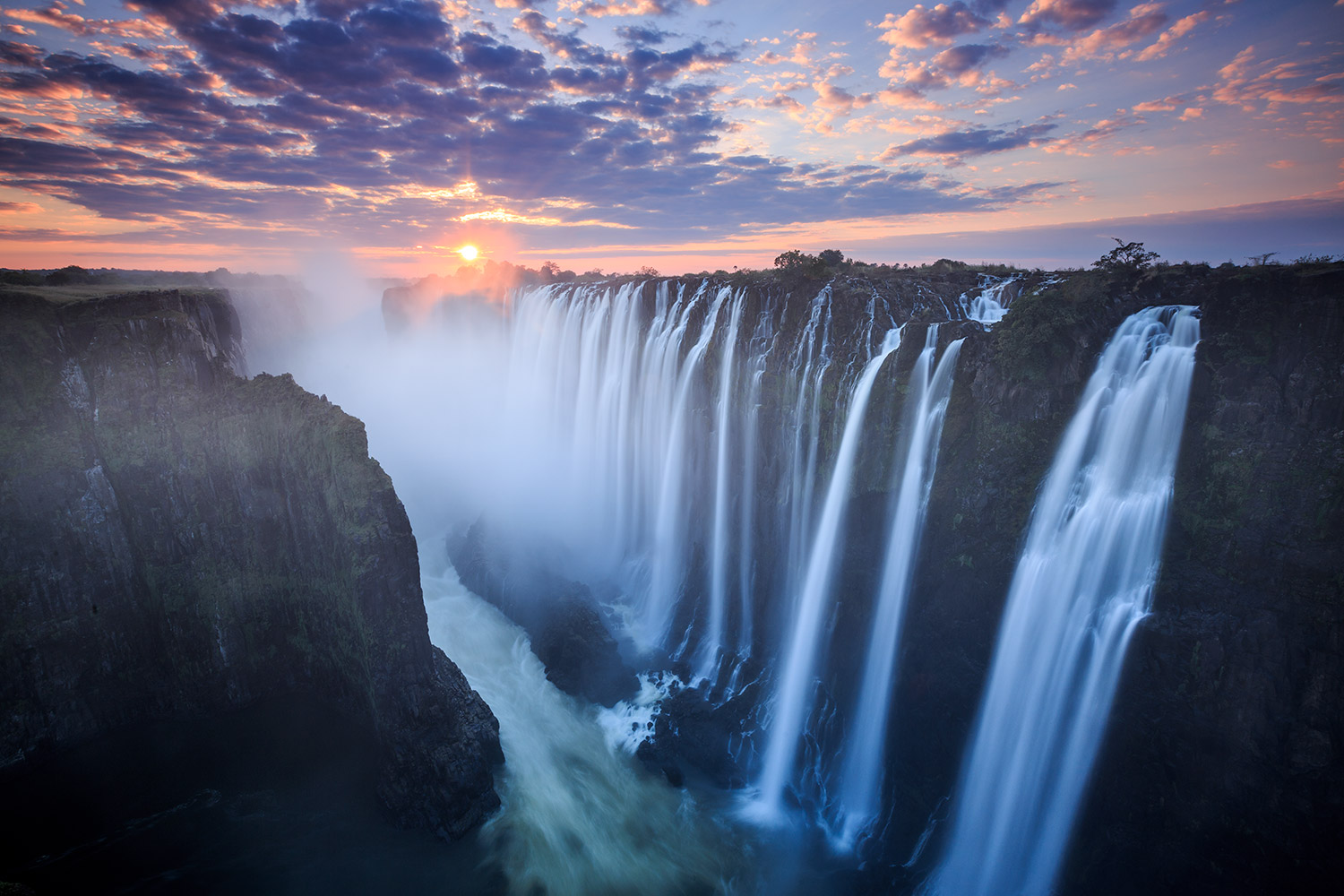
Figure 10. Majestic Victoria Falls
To reveal how colour can unlock the secrets of our universe's creation, I've come to one of the most spectacular natural wonders on Earth. This is Victoria Falls in Zambia. This waterfall stretches for almost two kilometres, making it the largest curtain of falling water in the world. But I'm not here to marvel at the scale of this wonder - I've come to see a much more delicate feature that appears above the water. These magnificent rainbows are a permanent feature in the skies above Victoria Falls.
Now, rainbows are a beautiful phenomenon, but I think that they're even more beautiful when you understand how they're made, because they are a visual representation of the fact that light is made up ofwell, all the colours of the rainbow. Rays of light from the sun bend as they enter the water droplets, the light beams then reflect off the back of the droplets, and are bent for a second time, as they leave. This bending and reflecting splits the light and the colours hidden inside the white sunlight are revealed.
But colour can tell us much more, because understanding the reddening of the galaxies has given us a profound insight into the nature of the universe. What we see as different colours are actually different wavelengths of light. So blue light has a relatively short wavelength, and then you go through green and yellow, all the way to the red end of the spectrum, which has a very large wavelength. Starlight is made up of countless different wavelengths, all the colours of the rainbow. When light is emitted by a distant star or galaxy, its wavelength doesn't have to stay fixed, it can be squashed or stretched, and when light's stretched, its wavelength increases and it moves to the red end of the spectrum.
So the interpretation of the fact that the most distant galaxies appear red is that the space in between them and us has stretched during the time it's taken the light to journey over that vast distance. That means that our entire universe is expanding. Now, just think about what an expanding universe implies, because if the galaxies are all rushing away from each other, that means that if you rewind time, then they must have been closer together in the past, and actually, if you just keep rewinding, then you find that at some point in the past, all the galaxies we can see in the sky were quite literally on top of each other.
The universe was squashed down to a point. That implies that the universe may have had a beginning, and that is the Big Bang Theory. Well, that's probably many people's picture of the Big Bang, you know, this vast explosion that flung matter out into the void, but that's completely wrong. As we understand it at the moment, all of space was created at that moment. So the Big Bang didn't just happen somewhere out over there in the universe, it happened everywhere at the same time.
It happened here. So this space here was at the Big Bang. So when we look at the distant galaxies and we see that they're flying away from us, that's not because they were flung out in some massive explosion at the beginning of time. It's because space itself is stretching, and it's been stretching since the Big Bang. The universe we see today is a network of galaxies spanning almost a hundred billion light years. But remarkably, the blueprint for this astonishing structure is written into the very first light released into the universe.

Figure 11. Namib Desert
Even more remarkably, it's a blueprint that we can read today. This first light is no longer visible, but it's there. You just need to know how to look for it. This sea of shifting sand is the Namib Desert (纳米布沙漠) , the oldest desert in the world, and, as the wind blows the sand off the top of the dunes, this landscape is constantly changing. This world has been sculpted by the sun. It drives the winds that shape the dunes, and its light paints this place a deep orange. But even when the sun disappears completely this desert is still awash with light and colour, we just can't see it.
Visible wavelengths of light are just a tiny fraction of all the light in the universe. Beyond the visible spectrum, our world is illuminated by invisible light. This sand has been under the full glare of the sun all day and I can feel the heat radiating off it. Well, heat is nothing more than a form of light, although we don't normally call it light. It's actually infrared light, and the only difference between infrared and visible light is the wavelength. Infrared has a longer wavelength than visible light. Infrared isn't the end of the story.
There are even longer wavelengths of light. Throughout most of human history we've been blind to these more unfamiliar forms of light, but to detect them you don't need a billion-pound satellite or a telescope built into the side of a mountain, you just need one of these, a radio. When we tune a radio, we're tuning in to a form of light, radio waves. But detecting them and understanding them provides the key to understanding the origin of the universe. And when you detune the radio a bit you can just hear static, but about 1% of that static is music to the ears of a physicist, because that is stretched light from the Big Bang.
So that sound is the sound of the first light released at the beginning of the universe. Carry him home safely to me The reason we can't see this ancient light is because, as the universe expanded, the light waves were stretched and transformed into radio waves and microwaves. This first light is called the Cosmic Microwave Background, or CMB. The CMB fills every part of the universe. Every second, light from the beginning of time is raining down on the surface of the Earth in a ceaseless torrent. If my eyes could only see it, then the sky would be ablaze with this primordial light, both day and night.
These waves have been travelling towards us for over 13 billion years. They are messengers, carrying information about the origin of our universe. In 2001, a satellite called W Map took a photograph of our entire sky to capture this ancient light. The image reveals that the blueprint of the entire universe was created moments after the Big Bang. Well, this is one of the most important images of the sky ever taken in the history of science. It doesn't have the beauty of a spiral galaxy or a nebula but to a scientist, to a cosmologist, it is the most beautiful picture ever taken, because it contains a vast amount of information about the very earliest history of our universe.
When the CMB was first detected, it appeared that the universe was exactly the same in all directions. But W Map shows us that the early universe was far from uniform. Some areas were denser than others, and it's these ripples that seeded all the structure in the cosmos. The explanation for those ripples in the CMB is absolutely mind blowing, because it's thought that they originated in the first billion-billion-billion- billionths of a second after the universe began, when the whole observable universe was billions of times smaller than a grain of sand and little fluctuations called quantum fluctuations made little bits of the universe a bit denser.
Those dense regions then got denser and denser as the universe continued to expand and they seeded the formation of the first stars and the first galaxies in the universe. The early universe was a hot, almost uniform, sea of matter and radiation. As the universe expanded, the slightly denser regions became increasingly dense. Atoms clumped together to form the first structures. Over time these structures grew so massive that they collapsed under their own gravity. Hydrogen fused, releasing enormous amounts of energy. 200 million years after the Big Bang, the first stars in the cosmos burst into life. Darkness was banished and the cosmos began to fill with light. Planets formed and fell into orbit around the stars and these young solar systems orbited the galaxies. And the only reason why any of this exists is because of those tiny density fluctuations that appeared when the observable universe was smaller than a grain of sand.
Without them there would be no planets or stars and no galaxies. Our universe would look the same in every direction. For billions of years, generations of stars lived and died. And then, nine billion years after it all began, in an unremarkable piece of space in the Orion spur of the Persius arm of a galaxy called the Milky Way, a star was born that we call the Sun, that illuminated our embryonic solar system with light. So the light from the star that bathes the Earth has its ultimate origin in the tiny ripples that appeared in the first moments of our universe's life. By capturing the light from the skies, we've been able to tell the story of the universe's origins and evolution, and it's worth reflecting on what a remarkable thing that is.
You know, little beings like me scurrying around on the surface of a rock on the edge of one of the galaxies have been able to understand the very origin and evolution of the universe. But there's one more twist to this story, because that ability to use light, to capture it, and use it to understand our world, may have played a key role in the emergence of complex life on Earth.

Figure 12. Breath-taking Yoho National Park
This is the Yoho National Park in the Rocky Mountains of Canada, one of the most spectacular mountain ranges in North America. 100 years ago, a fossil field was discovered here at the Burgess Shale that may reveal how light shaped life on Earth. Well, this is one of the most important fossil sites in the world, but actually it's one of the most important scientific sites of any kind, and it's not just because of the number and diversity of animals you find fossilised in these rocks, it's because of their age. These fossils are over 500 million years old.
There is virtually no record of complex life on Earth before this time. It's as if, at one instant in this time we call the Cambrian Era, complex multi-cellular life suddenly emerged almost intact on the planet. It's called the Evolutionary Big Bang. This is one of the beautiful animals you find up here in the fossil beds. It's called a trilobite. It's a very complex organism. It's got an external skeleton, it's got jointed limbs, but, perhaps most remarkably, these, because these are compound eyes. They were very sophisticated and this was one of the first predators to be able to detect shapes and see movement and it could successfully chase its prey.
These creatures were among the first to harness the light that filled the universe. Before they emerged, the rise and fall of the Sun and the stars in the night sky simply went unnoticed. Now, there is a speculative theory that the emergence of the eye actually triggered the Cambrian Explosion, this evolutionary Big Bang, because, once one species got eyes, then other species had also to develop eyes to either chase them as predators or evade them as prey, and that led to an evolutionary arms race. More and more complex life forms developed. So the evolution of the eye may have played a fundamental role in the emergence of complex life on Earth.

Figure 13. Pikaia
See, this little thing, although it looks unimpressive, may be the most important animal that we've ever discovered in our history. It's called a Pikaia (皮凯亚虫) and it's a little wormlike creature but it's thought that this is a core date, and that is the branch of life that we're in, so it could that this is our earliest known ancestor. What's also fascinating is it's also thought that this may have been able to detect light, it may have had primitive cells that were sensitive to light, and allowed it in a very loose sense to see. But if that's true then this little guy may be our direct ancestor and those little cells may be the things that evolved, over hundreds of millions of years, into our eyes.
Without Pikaia we may never have evolved and developed the ability to see how this story unfolded. Understanding the universe is like a detective story and the evidence has been carried to us across vast expanses of space by light. We've even been able to capture the light from the beginning of time and we've glimpsed in it the seeds of our own origins.
Come with me, and you'll be In a world of pure imagination Take a look and you'll see Into your imagination And we've seen things our ancestors wouldn't believe. Stars being born in distant realms. Alien worlds created by gravity. And spectacular galaxies frozen in time. But we're not mere witnesses to these events. Because the story of the universe is our story.
We've learned how the dust of the stars makes each and every one of us, how a simple universal chemistry set makes everything we see. We've explored how the secrets of deep time shape the destiny of the universe and marvelled at the brief flickering moment in which life can exist, and we've seen how stardust falls to build the grandest structures in the universe.
We know all this because of messages carried on beams of light. And isn't it a wonderful thing that these biological light detectors that first emerged half a billion years ago in the Cambrian Explosion have evolved into those most human of things, our green, blue and brown eyes that are able to gaze up into the night sky, capture the light from distant stars and read the story of the universe.
Come with me, and you'll be In a world of pure imagination Take a look and you'll see Into your imagination We'll begin with a spin Travelling in a world of my creation.
杀青咯!!!(/≧▽≦)/
